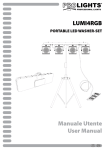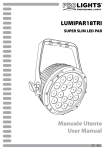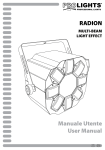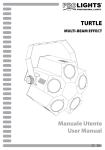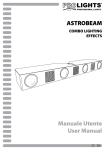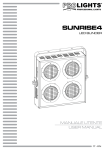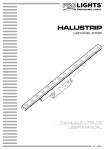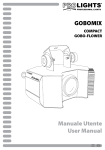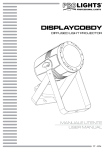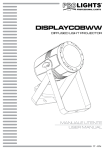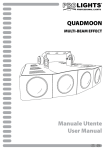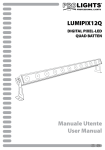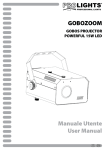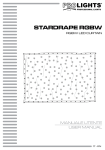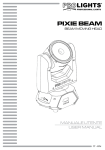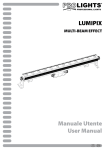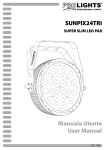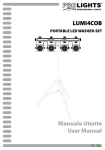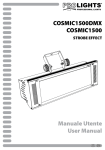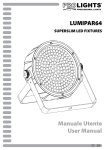Download Manuale Utente User Manual RADIONSTR
Transcript
RADIONSTR MULTI-BEAM COMBO EFFECT + STROBE Manuale Utente User Manual IT EN Music & Lights S.r.l. si riserva ogni diritto di elaborazione in qualsiasi forma delle presenti istruzioni per l’uso. La riproduzione - anche parziale - per propri scopi commerciali è vietata. Al fine di migliorare la qualità dei prodotti, la Music&Lights S.r.l. si riserva la facoltà di modificare, in qualunque momento e senza preavviso, le specifiche menzionate nel presente manuale di istruzioni. Tutte le revisioni e gli aggiornamenti sono disponibili nella sezione 'Manuali' sul sito www.musiclights.it REV.001-05/13 RADIONSTR INDICE Sicurezza Avvertenze generali Attenzioni e precauzioni per l’installazione Informazioni generali 4 4 5 1 Introduzione 1. 1 Descrizione 1. 2 Specifiche tecniche 1. 3 Elementi di comando e di collegamento 6 6 7 2 Installazione 2. 1 Montaggio 8 3 Funzioni e impostazioni 3. 1 Funzionamento 3. 2 Impostazione base 3. 3 Struttura menu 3. 4 Modalità automatica 3. 5 Modalità musicale 3. 6 Modalità Master/Slave 3. 7 Collegamento 3. 8 Modalità DMX 3. 9 Indirizzamento DMX 3. 10 Collegamenti della linea DMX 3. 11 Costruzione del terminatore DMX 3. 12 Tabella canali DMX 9 9 10 10 10 11 11 11 11 12 12 13 4 Manutenzione 4. 1 Manutenzione e pulizia del sistema ottico 4. 2 Risoluzione dei problemi 14 14 Certificato di garanzia Contenuto dell'imballo: 3 • • • • • RADIONSTR Cavo di alimentazione Staffa di fissaggio Cavo di sicurezza Manuale utente RADIONSTR 4 ATTENZIONE! Prima di effettuare qualsiasi operazione con l’unità, leggere con attenzione questo manuale e conservarlo accuratamente per riferimenti futuri. Contiene informazioni importanti riguardo l’installazione, l’uso e la manutenzione dell’unità. SICUREZZA Avvertenze generali • I prodotti a cui questo manuale si riferisce sono conformi alle Direttive della Comunità Europea e pertanto recano la sigla . • Il dispositivo funziona con pericolosa tensione di rete 230V~. Non intervenire mai al suo interno al di fuori delle operazioni descritte nel presente manuale; esiste il pericolo di una scarica elettrica. • È obbligatorio effettuare il collegamento ad un impianto di alimentazione dotato di un’efficiente messa a terra (apparecchio di Classe I secondo norma EN 60598-1). Si raccomanda, inoltre, di proteggere le linee di alimentazione delle unità dai contatti indiretti e/o cortocircuiti verso massa tramite l’uso di interruttori differenziali opportunamente dimensionati. • Le operazioni di collegamento alla rete di distribuzione dell’energia elettrica devono essere effettuate da un installatore elettrico qualificato. Verificare che frequenza e tensione della rete corrispondono alla frequenza ed alla tensione per cui l’unità è predisposta, indicate sulla targhetta dei dati elettrici. • L’unità non per uso domestico, solo per uso professionale. • Evitare di utilizzare l’unità: - in luoghi soggetti a vibrazioni, o a possibili urti; - in luoghi a temperatura superiore ai 45°C. • Evitare che nell’unità penetrino liquidi infiammabili, acqua o oggetti metallici. • Non smontare e non apportare modifiche all’unità. • Tutti gli interventi devono essere sempre e solo effettuati da personale tecnico qualificato. Rivolgersi al più vicino centro di assistenza tecnica autorizzato. • Se si desidera eliminare il dispositivo definitivamente, consegnarlo per lo smaltimento ad un’istituzione locale per il riciclaggio. Attenzioni e precauzioni per l’installazione • Se il dispositivo dovesse trovarsi ad operare in condizioni differenti da quelle descritte nel presente manuale, potrebbero verificarsi dei danni; in tal caso la garanzia verrebbe a decadere. Inoltre, ogni altra operazione potrebbe provocare cortocircuiti, incendi, scosse elettriche, rotture etc. • Questo prodotto è solo per uso interno. Per prevenire il rischio di incendi o scosse elettriche, non esporre il prodotto alla pioggia o all’umidità. • Installare l’unità in un luogo ben ventilato. La distanza minima tra il dispositivo e le pareti circostanti deve essere superiore a 50 cm. • Prima di iniziare qualsiasi operazione di manutenzione o pulizia sull’unità togliere la tensione dalla rete di alimentazione. • È assolutamente necessario proteggere l’unità per mezzo di una fune di sicurezza. Nell’eseguire qualsiasi intervento attenersi scrupolosamente a tutte le normative (in materia di sicurezza) vigenti nel paese di utilizzo. • Mantenere i materiali infiammabili ad una distanza di sicurezza dall’unità. • I filtri, le lenti o gli schermi ultravioletti se danneggiati possono limitare la loro efficienza. • I LED devono essere sostituiti se danneggiati o termicamente deformati. • Non guardare direttamente il fascio luminoso. Tenere presente che i veloci cambi di luce possono provocare attacchi d’epilessia presso persone fotosensibili o epilettiche. • Non collegare l’unità a un dimmer pack. RADIONSTR 5 INFORMAZIONI GENERALI Spedizioni e reclami Le merci sono vendute “franco nostra sede” e viaggiano sempre a rischio e pericolo del distributore/cliente. Eventuali avarie e danni dovranno essere contestati al vettore. Ogni reclamo per imballi manomessi dovrà essere inoltrato entro 8 giorni dal ricevimento della merce. Garanzie e resi Il prodotto è coperto da garanzia in base alle vigenti normative. Sul sito www.musiclights.it è possibile consultare il testo integrale delle “Condizioni Generali di Garanzia”. Si prega, dopo l’acquisto, di procedere alla registrazione del prodotto sul sito www.musiclights.it. In alternativa il prodotto può essere registrato compilando e inviando il modulo riportato alla fine del manuale. A tutti gli effetti la validità della garanzia è avallata unicamente dalla presentazione del certificato di garanzia. Music & Lights constata tramite verifica sui resi la difettosità dichiarata, correlata all’appropriato utilizzo, e l’effettiva validità della garanzia; provvede quindi alla riparazione dei prodotti, declinando tuttavia ogni obbligo di risarcimento per danni diretti o indiretti eventualmente derivanti dalla difettosità. 6 RADIONSTR - 1 - INTRODUZIONE 1.1 DESCRIZIONE Effetto combo multi-raggio+strobo con tecnologia LED 5 colori (RGBWA) ed SMD5050 per la sezione strobo. Le 8 lenti di proiezione offrono un ampio angolo di emissione, producendo centinaia di raggi multicolore in movimento e rotazione. Il ring di LEDs bianchi centrale riproduce un effetto strobo in grado di abbagliare il pubblico. 1.2 SPECIFICHE TECNICHE • Sorgente Luminosa: 5x3W RGBWA LED + 42 LED SMD5050 bianchi • Miscelazione colore: RGBWA per una gamma cromatica senza limiti • Tipologia di effetto: effetto combo multi-raggio+ strobo ad ampia emissione, con fasci multicolore e rotanti • Durata media diodi LED: >50.000 ore • Angolo di proiezione: 65°, le 8 lenti producono centinaia di punti luce • Rotazione fasci controllabile in senso orario e antiorario • Pannello di controllo e interfaccia utente tramite display LED (4-caratteri) • Modalità Automatica: programmi automatici preimpostati con regolazione velocità • Modalità DMX: 2/5 canali di funzionamento per il controllo indipendente dei giochi di luce, colori ed effetto strobo • Modalità Master/Slave: per il controllo di più unità collegate in catena • Modalità Sound: attivazione musicale tramite microfono interno, controllo sensibilità • Connessioni: XLR-3p (segnale), presa VDE (alimentazione) • Alimentazione: AC 100/240V, 50/60Hz • Assorbimento medio: 30W • Output alimentazione per connessione di più unità in serie: fino a 21 proiettori a 230V • Peso: 3,7 kg • Dimensioni (LxAxP): 200 x 300 x 310 mm RADIONSTR 7 1.3 ELEMENTI DI COMANDO E DI COLLEGAMENTO 1 2 3 4 5 6 7 RadionSTR 8 9 11 10 Fig.1 Pannello posteriore 1. STAFFA DI MONTAGGIO 2. MANOPOLA DI FISSAGGIO per la staffa di montaggio 3. PANNELLO DI CONTROLLO con display LED e 4 pulsanti per accesso e gestione delle diverse funzioni 4. MICROFONO per il comando tramite musica 5. REGOLATORE SENSIBILITÀ AUDIO nella modalità sound 6. DMX IN (XLR a 3 poli): 1 = massa, 2 = DMX -, 3 = DMX + 7. DMX OUT (XLR a 3 poli): 1= massa, 2 = DMX -, 3 = DMX + 8. GND POINT usato per la messa a terra del dispositivo 9. POWER OUT output alimentazione per connessioni di più unità in serie 10. POWER IN spina da pannello VDE per il collegamento ad una presa di rete (110-240V~/50-60Hz) tramite il cavo di rete in dotazione. Sopra la spina si trova il portafusibile. Sostituire un fusibile difettoso solo con uno dello stesso tipo. 11. SAFETY EYE per l'aggancio al cavo di sicurezza RADIONSTR 8 - 2 - INSTALLAZIONE 2.1 MONTAGGIO Il RADIONSTR può essere collocato su un piano solido. Inoltre, grazie alle possibilità di fissaggio sulla doppia staffa (fig.2), l’unità può essere montata anche a testa in giù, su una traversa. Per il fissaggio occorrono dei supporti robusti per il montaggio. L’area di collocazione deve avere una stabilità sufficiente e supportare almeno 10 volte il peso dell’unità. Assicurarsi di rispettare tutte le avvertenze in materia di sicurezza. • Fissare il proiettore attraverso l’apposita staffa (1) ad una collocazione idonea. • È assolutamente necessario assicurare il proiettore contro la caduta utilizzando un cavo di sicurezza: in particolare collegare il cavo in un punto adatto in modo che la caduta del proiettore non possa superare i 20 cm. • Orientare il proiettore intervenendo, se necessario, sulla manopola della staffa di montaggio (2) 1 2 Fig.2 RADIONSTR 9 - 3 - FUNZIONI E IMPOSTAZIONI 3.1 FUNZIONAMENTO Per accendere il RADIONSTR, inserire la spina del cavo di alimentazione in una presa di rete (110-240VAC~ 50Hz). L’unità può essere comandata da un unità DMX di comando luce oppure svolgere autonomamente il suo programma. Per spegnere il RADIONSTR, staccare la spina dalla presa di rete. Per maggiore comodità è consigliabile collegare l’unità con una presa comandata da un interruttore. 3.2 IMPOSTAZIONE BASE Il proiettore RADIONSTR dispone di un LED display e 4 pulsanti per accesso alle funzioni del pannello di controllo (fig.3). Fig.3 MODE DOWN Per scorrere il menu principale Per diminuire il valore della o tornare ad una opzione del funzione menu precedente UP ENTER Per aumentare il valore della Per attivare una funzione e funzione stessa per memorizzare un valore RADIONSTR 10 3.3 STRUTTURA MENU MAIN FUNCTION SELECTION1 SELECTION2 DESCRIPTION 001 - d512 DMX Operation and Select the DMX starting address 2-CH DMX Mode 5-CH AUTO Trigger the built-in program with variable speed S01-S100 Adjust the speed of the automatic program Automatic Mode SNd1 Sound Mode SNd2 Trigger the built-in program to the beat of the music, using the internal microphone Funzionamento Standalone Il RADIONSTR dispone di due opzioni per il funzionamento senza un controller DMX: 3.4 MODALITÀ AUTOMATICA Per entrare nella modalità automatica e permettere all’unità di svolgere il suo programma Show autonomamente: • Premere il tasto MODE fino a quando sul display non appare [AUTO], quindi premere ENTER per confermare. L’unità entrerà nella modalità automatica mandando in esecuzione il programma pre-impostato per il quale è possibile regolare la velocità di esecuzione. • Per impostare la velocità di esecuzione premere il tasto MODE fino a quando sul display non appare [S--], quindi utilizzare i tasti UP/DOWN per selezionare la velocità di esecuzione desiderata (Slow-Fast) [S001 - S100]. • Premere il tasto ENTER per salvare l’impostazione. NOTA - Quando il proiettore è nella modalità automatica, il LED AUTO di colore blu si illuminerà per indicare che la modalità è attiva. 3.5 MODALITÀ MUSICALE • Per entrare nella modalità musicale, premere il tasto MODE fino a quando sul display non appare [SNd1], o [SNd2], quindi premere ENTER per confermare. La modalità SNd1 indica la modalità musicale senza strobo; la modalità SNd2 indica la modalità musicale con strobo. • Regolare la sensibilità del microfono integrato con la relativa manopola di regolazione. NOTA - Quando il proiettore è nella modalità musicale, il LED SOUND di colore verde si illuminerà per indicare che la modalità è attiva RADIONSTR 11 3.6 MODALITÀ MASTER/SLAVE Questa modalità consente di collegare in linea più unità RADIONSTR senza un controller. La prima sarà impostata come master e le altre come slave. Per questa modalità è necessario impostare correttamente le unità: IMPOSTAZIONE UNITÀ MASTER • Servirsi dei connettori DMX del RADIONSTR e di un cavo XLR per formare una catena di unità. In certe condizioni e lunghezze si consiglia di effettuare una terminazione come mostrato a pagina 12. • Impostare una delle modalità standalone per l’unità master (vedi 3.4 - 3.5). IMPOSTAZIONE UNITÀ SLAVE • Impostare sulle unità slave la stessa configurazione canali DMX: [CH2] o [CH5]. NOTA - Quando il proiettore è nella modalità Master/Slave, il LED DMX e SLAVE rispettivamente di colore rosso e giallo, si illumineranno per indicare che la modalità è attiva. 3.7 COLLEGAMENTO 1. Collegare l’uscita DMX OUT dell’unità principale con l’ingresso DMX IN della prima unità secondaria servendosi di un cavo XLR a 3 poli. 2. Collegare l’uscita DMX OUT della prima unità secondaria con l’ingresso DMX IN della seconda unità secondaria ecc. 3.8 MODALITÀ DMX • Per poter entrare nella modalità DMX, premere il tasto MODE fino a quando sul display non appare [CH2] o [CH5], quindi premere ENTER per confermare. • Utilizzare i tasti UP/DOWN per impostare l’indirizzo DMX desiderato [d001 - d512]. Tenere premuto per lo scorrimento veloce. • Premere ENTER per confermare Le tabelle a pagina 13 indicano le modalità di funzionamento e i relativi valori DMX. Come interfaccia DMX, l’unità possiede dei contatti XLR a 3. NOTA - Quando il proiettore è nella modalità DMX, il LED DMX di colore rosso, si illuminerà per indicare che la modalità è attiva. 3.9 INDIRIZZAMENTO DMX Per poter comandandare il proiettore RADIONSTR con un’unità di comando luce, occorre impostare l’indirizzo di start DMX per il primo canale DMX. Se, per esempio, sull’unità di comando è previsto l’indirizzo 33 per comandare la funzione del primo canale DMX, si deve impostare sul RADIONSTR l’indirizzo di start 33. Le altre funzioni del pannello saranno assegnate automaticamente agli indirizzi successivi. Segue un esempio con indirizzo 33 di start: Numero canali DMX Indirizzo di start (esempio) Indirizzo DMX occupati Prossimo indirizzo di start possibile per unità n°1 Prossimo indirizzo di start possibile per unità n°2 Prossimo indirizzo di start possibile per unità n°3 2 33 33-34 35 37 39 5 33 33-37 38 43 48 RADIONSTR 12 3.10 COLLEGAMENTI DELLA LINEA DMX La connessione DMX è realizzata con connettori standard XLR. Utilizzare cavi schermati, 2 poli ritorti, con impedenza 120Ω e bassa capacità. Per il collegamento fare riferimento allo schema di connessione riportato di seguito: DMX - INPUT Spina XLR DMX - OUTPUT Presa XLR Pin1 : Massa - Schermo Pin2 : - Negativo Pin3 : + Positivo Fig.4 ATTENZIONE La parte schermata del cavo (calza) non deve mai essere collegata alla terra dell’impianto; ciò comporterebbe malfunzionamenti delle unità e dei controller. Per passaggi lunghi può essere necessario l’inserimento di un amplificatore DMX. In tal caso, è sconsigliato utilizzare nei collegamenti cavo bilanciato microfonico poiché non è in grado di trasmettere in modo affidabile i dati di controllo DMX. • Collegare l’uscita DMX del controller con l’ingresso DMX della prima unità; • Collegare, quindi, l’uscita DMX con l’ingresso DMX della successiva unità; l’uscita di quest’ultima con l’ingresso di quella successiva e via dicendo finchè tutte le unità sono collegate formando una catena. • Per installazioni in cui il cavo di segnale deve percorrere lunghe distanze è consigliato inserire sull’ultima unità una terminazione DMX. 3.11 COSTRUZIONE DEL TERMINATORE DMX La terminazione evita la probabilità che il segnale DMX 512, una volta raggiunta la fine della linea stessa venga riflesso indietro lungo il cavo, provocando, in certe condizioni e lunghezze, la sua sovrapposizione al segnale originale e la sua cancellazione. La terminazione deve essere effettuata, sull’ultima unità della catena, con connettori XLR a 3 pin, saldando una resistenza di 120Ω (minimo 1/4W) tra i terminali 2 e 3, così come indicato in figura. Esempio: connettore XLR a 3 pin Fig.5 RADIONSTR 13 3.12 TABELLA CANALI DMX CH5 CH Function in CH5 mode CH2 Value 1 COLOR/MODE Blackout Red Green Blue White Amber Green + Blue Red + Blue Red + Green Red + White Red + Amber Green + White Green + Amber Blue + White Blue + Amber Red + Green + Blue + White + Amber Auto Program 1 (Single color) Auto Program 2 (Two colors) Auto Program 3 (Fast) Auto Program 4 (Slow) Sound Active (W/O SMD strobe) Sound Active (W/SMD strobe) 000 - 005 006 - 010 011 - 015 016 - 021 022 - 027 028 - 033 034 - 039 040 - 045 046 - 051 052 - 057 058 - 063 064 - 069 070 - 075 076 - 081 082 - 087 088 - 093 094 - 123 124 - 185 186 - 218 219 - 250 251 - 254 255 2 AUTOMATIC SPEED (when CH1 is between 094 - 185) Speed of Auto Program 1 and 2 000 - 255 3 SIDE LENSES No Function Strobe (slow - fast) (CH1@006-185)) Strobe actived by sound 000 - 009 010 - 254 255 4 MOTOR ROTATION Stop Motor rotation clockwise (slow-fast) Stop Motor rotation counter-clockwise (slow-fast) 000 - 004 005 - 127 128 - 133 134 - 255 5 MIDDLE SMD No Function SMD Strobe (slow - fast) 000 - 010 011 - 255 CH Function in CH2 mode Value 1 MODE Blackout Auto Program Slow speed Auto Program Middle speed Auto Programs Fast speed Sound active 000 - 015 016 - 089 090 - 164 165 - 240 241 - 255 2 SMD STROBE No Function SMD Strobe speed (slow - fast) 000 - 009 010 - 255 RADIONSTR 14 - 4 - MANUTENZIONE 4.1 MANUTENZIONE E PULIZIA DEL SISTEMA OTTICO • Durante gli interventi, assicurarsi che l’area sotto il luogo di installazione sia libera da personale non qualificato. • Spegnere l’unità, scollegare il cavo di alimentazione ed aspettare finché l’unità non si sia raffreddata. • Tutte le viti utilizzate per l’installazione dell’unità e le sue parti devono essere assicurate saldamente e • non devono essere corrose. • Alloggiamenti, elementi di fissaggio e di installazione (soffitto, truss, sospensioni) devono essere totalmente esenti da qualsiasi deformazione. • I cavi di alimentazione devono essere in condizione impeccabile e devono essere sostituiti immediatamente nel momento in cui anche un piccolo problema viene rilevato. • Si dovrebbe procedere, ad intervalli regolari, alla pulizia della parte frontale per asportare polvere, fumo e altre particelle. Solo così, la luce può essere irradiata con la luminosità massima. Per la pulizia usare un panno morbido, pulito e un detergente per vetri come si trovano in commercio. Quindi asciugare le parti delicatamente. 4.2 RISOLUZIONE DEI PROBLEMI Anomalie Possibili cause Il proiettore non illumina • • • • • Bassa intensità di luce generale Il proiettore non è alimentato Il proiettore non risponde al DMX Controlli e rimedi • • • • • • • Mancanza di alimentazione di rete Dimmer impostato a 0 Tutti i colori impostati a 0 LED difettoso/i Scheda LED difettosa Lenti sporche Lente disallineata • • Verificare la presenza della tensione alimentazione Incrementare i valori del canale dimmer Incrementare i valori dei canali colori Sostituire scheda LED Sostituire scheda LED Pulire il dispositivo regolarmente Installare il gruppo ottico correttamente • • • Mancanza di alimentazione di rete Cavo di alimentazione danneggiato Alimentatore interno difettoso • • • Verificare la presenza della tensione alimentazione Controllare il cavo di alimentazione Sostituire l'alimentatore interno • Indirizzamento DMX errato • • • Cavo di segnale DMX difettoso Rimbalzo segnale DMX • • Controllare il pannello di controllo e l'indirizzamento delle unità Controllare il cavo di segnale DMX Installare una terminazione DMX come suggerito Rivolgersi a un centro di assistenza tecnico autorizzato in caso di problema non riportato in tabella o che non possono essere risolti mediante la procedura riportata in tabella. All rights reserved by Music & Lights S.r.l. No part of this instruction manual may be reproduced in any form or by any means for any commercial use. In order to improve the quality of products, Music&Lights S.r.l. reserves the right to modify the characteristics stated in this instruction manual at any time and without prior notice. All revisions and updates are available in the ‘manuals’ section on site www.musiclights.it RADIONSTR TABLE OF CONTENTS Safety General instructions Warnings and installation precautions General information 2 2 3 1 Introduction 1. 1 Description 1. 2 Technical specifications 1. 3 Operating elements and connections 4 4 5 2 Installation 2. 1 Mounting 6 3 Functions and settings 3. 1 Operation 3. 2 Basic 3. 3 Menu structure 3. 4 Automatic mode 3. 5 Sound active 3. 6 Master/Slave mode 3. 7 Linking 3. 8 DMX operation 3. 9 DMX addressing 3. 10 Connection of the DMX line 3. 11 Construction of the DMX termination 3. 12 DMX control 7 7 8 8 8 8 9 9 9 10 10 11 4 Maintenance 4. 1 Maintenance and cleaning the unit 4. 2 Trouble shooting 12 12 Warranty Packing content 1 • • • • • RADIONSTR Bracket and mounting knobs Safety cable Power cord User manual RADIONSTR 2 WARNING! Before carrying out any operations with the unit, carefully read this instruction manual and keep it with cure for future reference. It contains important information about the installation, usage and maintenance of the unit. SAFETY General instruction • The products referred to in this manual conform to the European Community Directives and are therefore marked with . • The unit is supplied with hazardous network voltage (230V~). Leave servicing to skilled personnel only. Never make any modifications on the unit not described in this instruction manual, otherwise you will risk an electric shock. • Connection must be made to a power supply system fitted with efficient earthing (Class I appliance according to standard EN 60598-1). It is, moreover, recommended to protect the supply lines of the units from indirect contact and/or shorting to earth by using appropriately sized residual current devices. • The connection to the main network of electric distribution must be carried out by a qualified electrical installer. Check that the main frequency and voltage correspond to those for which the unit is designed as given on the electrical data label. • This unit is not for home use, only professional applications. • Never use the fixture under the following conditions: - in places subject to vibrations or bumps; - in places with a temperature of over 45°C. • Make certain that no inflammable liquids, water or metal objects enter the fixture. • Do not dismantle or modify the fixture. • All work must always be carried out by qualified technical personnel. Contact the nearest sales point for an inspection or contact the manufacturer directly. • If the unit is to be put out of operation definitively, take it to a local recycling plant for a disposal which is not harmful to the environment. Warnings and installation precautions • If this device will be operated in any way different to the one described in this manual, it may suffer damage and the guarantee becomes void. Furthermore, any other operation may lead to dangers like short circuit, burns, electric shock, etc. • The unit for indoor use only. To prevent or reduce the risk of electrical shock or fire, do not expose the unit to rain or moisture. • Install the fixture in a well ventilated place. The minimum distance between the fixture and surrounding walls must be more than 50 cm. • Before starting any maintenance work or cleaning the projector, cut off power from the main supply. • Always additionally secure the projector with the safety rope. When carrying out any work, always comply scrupulously with all the regulations (particularly regarding safety) currently in force in the country in which the fixture’s being used. • Keep any inflammable material at a safe distance from the fixture. • Shields, lenses or ultraviolet screens shall be changed if they have become damaged to such an extent that their effectiveness is impaired. • The lamp (LED) shall be changed if it has become damaged or thermally deformed. • Never look directly at the light beam. Please note that fast changes in lighting, e. g. flashing light, may trigger epileptic seizures in photosensitive persons or persons with epilepsy. • Don’t connect the device to a dimmer pack. RADIONSTR 3 GENERAL INFORMATION Shipments and claims The goods are sold “ex works” and always travel at the risk and danger of the distributor. Eventual damage will have to be claimed to the freight forwarder. Any claim for broken packs will have to be forwarded within 8 days from the reception of the goods. Warranty and returns The guarantee covers the fixture in compliance with existing regulations. You can find the full version of the “General Guarantee Conditions” on our web site www.musiclights.it. Please remember to register the piece of equipment soon after you purchase it, logging on www.musiclights.it. The product can be also registered filling in and sending the form available on your guarantee certificate. For all purposes, the validity of the guarantee is endorsed solely on presentation of the guarantee certificate. Music & Lights will verify the validity of the claim through examination of the defect in relation to proper use and the actual validity of the guarantee. Music & Lights will eventually provide replacement or repair of the products declining, however, any obligation of compensation for direct or indirect damage resulting from faultiness. 4 RADIONSTR - 1 - INTRODUCTION 1.1 DESCRIPTION Multi-beam combo effect + Strobe with LED 5 color technology (RGBWA) and SMD5050 for the strobe section. The 8 projection lenses offer a wide emission angle, producing hundreds of multicolored rays in motion and rotation. The central ring of white LEDs play a strobe effect that can dazzle the audience. 1.2 TECHNICAL SPECIFICATIONS • Light source: 5x3W RGBWA LED + 42 LED SMD5050 white • Color mixing: RGBWA for a limitless range of colors • Type of effect: effect combo multi-beam strobe + wide issue, with multicolored beams and rotating • LEDs average life span:> 50,000 hours • Beam angle: 65 °, 8 lenses produce hundreds of points of light • Controllable beam rotation clockwise and counterclockwise • Control panel and user interface through LED display (4-digits) • Auto mode: preset automatic programs with speed control • DMX mode: 2/5 channels of operation for the independent control of the play of light, color and strobe effect • Master / Slave: For the control of several units linked in a chain • Sound Mode: Switch music via the internal microphone, sensitivity control • Connections: XLR-3p (signal), VDE plug (power supply) • Power Supply: AC 100/240V, 50/60Hz • Average power consumption: 30W • Power output for connection of multiple units in series: up to 21 projectors at 230V • Weight: 3.7 kg • Dimensions (WxHxD): 200 x 300 x 310 mm RADIONSTR 5 1.3 OPERATING ELEMENTS AND CONNECTIONS 1 2 3 4 5 6 7 RadionSTR 8 9 11 10 Fig.1 Rear panel 1. MOUNTING BRACKET 2. LOCKING KNOB for the mounting bracket. 3. CONTROL PANEL with display, 4 LED and 4 button used to access the control panel functions and manage them. 4. MICROPHONE to control the show by the external audio signal. 5. CONTROL SENSITIVITY for the sensitivity of response in case of music control via the internal microphone. 6. DMX IN (3-pole XLR): 1 = ground, 2 = DMX -, 3 = DMX 7. DMX OUT (3-pole XLR): 1= ground, 2 = DMX -, 3 = DMX + 8. GND POINT grounding the fixture to the earth 9. POWER OUT power output for connection of multiple units in series 10. POWER IN mains plug for connection to a socket (100-240V 50/60Hz) via the supplied mains cable. The support for the mains fuse is located near the mains plug. Only replace a blown fuse by one of the same type. 11. SAFETY EYE to attach safety cable RADIONSTR 6 - 2 - INSTALLATION 2.1 MOUNTING RADIONSTR may be set up on a solid and even surface. The unit can also be mounted upside down to a cross arm. For fixing, stable mounting clips are required. The mounting place must be of sufficient stability and be able to support a weight of 10 times of the unit’s weight. When carrying out any installation, always comply scrupulously with all the regulations (particularly regarding safety) currently in force in the country in which the fixture’s being used. • Install the projector at a suitable location by means of the mounting bracket (1). • Always additionally secure the projector with the safety rope from falling down. For this purpose, fasten the safety rope at a suitable position so that the maximum fall of the projector will be 20 cm. • Adjust the projector and use the knob (2) to slightly release or tighten the locking mechanism of the bracket if is necessary. 1 2 Fig.2 RADIONSTR 7 - 3 - FUNCTIONS AND SETTINGS 3.1 OPERATION Connect the supplied main cable to a socket (100-240 VAC-50/60 Hz). Then the unit is ready for operation and can be operated via a DMX controller or it independently performs its show program in succession. To switch off, disconnect the mains plug from the socket. For a more convenient operation it is recommended to connect the unit to a socket which can be switched on and off via a light switch. 3.2 BASIC Access control panel functions using the four panel buttons located directly underneath the LED Display (fig.3). Fig.3 MODE DOWN Used to scroll through the Used to select a decreasing current operating mode, as value well as back out of the current menu option UP Used to select an increasing value ENTER Used to activate a selection and store it to memory RADIONSTR 8 3.3 MENU STRUCTURE MAIN FUNCTION SELECTION1 SELECTION2 DESCRIPTION 001 - d512 DMX Operation and Select the DMX starting address 2-CH DMX Mode 5-CH AUTO Trigger the built-in program with variable speed S01-S100 Adjust the speed of the automatic program Automatic Mode SNd1 Sound Mode SNd2 Trigger the built-in program to the beat of the music, using the internal microphone Standalone This fixture has several options for operating without a DMX controller. Access these options via the control panel on the back of the fixture. 3.4 AUTOMATIC MODE This fixture has a built-in automatic program. To access this, please see the below instructions: • Press the button MODE so many times until shows [AUTO], then press the button ENTER. • Press the button MODE until [S--] appears on the display. • Use the button UP/DOWN to select the auto programs speed [S001 - S100] (slow-fast). • Press the button ENTER save the setting. NOTE - When the fixture is in automatic mode, the blue AUTO LED will illuminate. 3.5 SOUND ACTIVE Please see the instructions below for details on this mode. • Press the button MODE so many times until shows [SNd 1] or [SNd 2], then press the button ENTER to confirm. SNd1 = sound mode without SMD stobe; SNd2 = sond mode with SMD strobe. • Use the microphone sensitivity adjustment knob to adjust the fixture to react to the beat of the music. NOTE - When the fixture is in sound-active mode, the green SOUND LED will illuminate. 3.6 MASTER/SLAVE MODE This mode will allow you to link up the units together without a controller. Choose a unit to function as the Master. The unit must be the first unit in line; other units will work as slave with the same effect. MASTER SETTINGS • Use standard DMX cables to daisy chain your units together via the DMX connector on the rear of the units. For longer cable runs we suggest a terminator at the last fixture (see page 10). RADIONSTR 9 • Set the master fixture to operate in either automatic or sound-active mode. SLAVE SETTINGS • Set the slaves to the same DMX modes [CH2] or [CH5]. NOTE - When the fixture is in slave mode, the red DMX and the yellow SLAVE LED will illuminate. 3.7 LINKING 1. Connect the DMX OUT of the master unit via 3-pole XLR cable to the DMX IN of the first slave unit. 2. Connect the DMX OUT of the first slave unit to the DMX IN of the second slave unit, etc. until all units are connected in a chain. 3.8 DMX OPERATION • Press the button MODE so many times until shows [CH2] or [CH5] and press the button ENTER to confirm. • Press the button UP/DOWN to select the desired DMX address [d001 - d512]. Press and hold to scroll quickly. • Press ENTER button to store. • Press the MODE button to go back or to meet the waiting time to exit the setup menu. The tables on page 11 indicate the operating mode and DMX value. The RADIONSTR is equipped with 3-pole XLR connections. NOTE - When the fixture is in DMX mode, the red DMX LED will illuminate. 3.9 DMX ADDRESSING To able to operate the RADIONSTR with a light controller, adjust the DMX start address for the first a DMX channel. If e. g. address 33 on the controller is provided for controlling the function of the first DMX channel, adjust the start address 33 on the RADIONSTR. The other functions of the light effect panel are then automatically assigned to the following addresses. An example with the start address 33 is shown below: Number of DMX channels Start address (example) DMX Address occupied Next possible start address for unit No. 1 Next possible start address for unit No. 2 Next possible start address for unit No. 3 2 33 33-34 35 37 39 5 33 33-37 38 43 48 RADIONSTR 10 3.10 CONNECTION OF THE DMX LINE DMX connection employs standard XLR connectors. Use shielded pair-twisted cables with 120Ω impedance and low capacity. The following diagram shows the connection mode: DMX - INPUT XLR plug DMX - OUTPUT XLR socket Pin1 : GND - Shield Pin2 : - Negative Pin3 : + Positive Fig.4 ATTENTION The screened parts of the cable (sleeve) must never be connected to the system’s earth, as this would cause faulty fixture and controller operation. Over long runs can be necessary to insert a DMX level matching amplifier. For those connections the use of balanced microphone cable is not recommended because it cannot transmit control DMX data reliably. • Connect the controller DMX input to the DMX output of the first unit. • Connect the DMX output to the DMX input of the following unit. Connect again the output to the input of the following unit until all the units are connected in chain. • When the signal cable has to run longer distance is recommended to insert a DMX termination on the last unit. 3.11 CONSTRUCTION OF THE DMX TERMINATION The termination avoids the risk of DMX 512 signals being reflected back along the cable when they reaches the end of the line: under certain conditions and with certain cable lengths, this could cause them to cancel the original signals. The termination is prepared by soldering a 120Ω 1/4 W resistor between pins 2 and 3 of the 3-pin male XLR connector, as shown in figure. Example: 3 pin XLR connector Fig.5 RADIONSTR 11 3.12 DMX CONTROL CH5 CH Function in CH5 mode CH2 Value 1 COLOR/MODE Blackout Red Green Blue White Amber Green + Blue Red + Blue Red + Green Red + White Red + Amber Green + White Green + Amber Blue + White Blue + Amber Red + Green + Blue + White + Amber Auto Program 1 (Single color) Auto Program 2 (Two colors) Auto Program 3 (Fast) Auto Program 4 (Slow) Sound Active (W/O SMD strobe) Sound Active (W/SMD strobe) 000 - 005 006 - 010 011 - 015 016 - 021 022 - 027 028 - 033 034 - 039 040 - 045 046 - 051 052 - 057 058 - 063 064 - 069 070 - 075 076 - 081 082 - 087 088 - 093 094 - 123 124 - 185 186 - 218 219 - 250 251 - 254 255 2 AUTOMATIC SPEED (when CH1 is between 094 - 185) Speed of Auto Program 1 and 2 000 - 255 3 SIDE LENSES No Function Strobe (slow - fast) (CH1@006-185)) Strobe actived by sound 000 - 009 010 - 254 255 4 MOTOR ROTATION Stop Motor rotation clockwise (slow-fast) Stop Motor rotation counter-clockwise (slow-fast) 000 - 004 005 - 127 128 - 133 134 - 255 5 MIDDLE SMD No Function SMD Strobe (slow - fast) 000 - 010 011 - 255 CH Function in CH2 mode Value 1 MODE Blackout Auto Program Slow speed Auto Program Middle speed Auto Programs Fast speed Sound active 000 - 015 016 - 089 090 - 164 165 - 240 241 - 255 2 SMD STROBE No Function SMD Strobe speed (slow - fast) 000 - 009 010 - 255 RADIONSTR 12 - 4 - MAINTENANCE 4.1 MAINTENANCE AND CLEANING THE UNIT • Make sure the area below the installation place is free from unwanted persons during setup. • Switch off the unit, unplug the main cable and wait until the unit has cooled down. • All screws used for installing the device and any of its parts should be tightly fastened and should not be corroded. • Housings, fixations and installation spots (ceiling, trusses, suspensions) should be totally free from any deformation. • The main cables must be in impeccable condition and should be replaced immediately even when a small problem is detected. • It is recommended to clean the front at regular intervals, from impurities caused by dust, smoke, or other particles to ensure that the light is radiated at maximum brightness. For cleaning, disconnect the main plug from the socket. Use a soft, clean cloth moistened with a mild detergent. Then carefully wipe the part dry. For cleaning other housing parts use only a soft, clean cloth. Never use a liquid, it might penetrate the unit and cause damage to it. 4.2 TROUBLESHOOTING Problems Possible causes Checks and remedies Fixture does not light up • • • • • No mains supply Dimmer fader set to 0 All color faders set to 0 Faulty LED Faulty LED board • • • • • Check the power supply voltage Increase the value of the dimmer channels Increase the value of the color channels Replace the LED board Replace the LED board General low light intensity • • Dirty lens assembly Misaligned lens assembly • • Clean the fixture regularly Install lens assembly properly Fixture does not power up • • • No power Loose or damaged power cord Faulty internal power supply • • • Check for power on power outlet Check power cord Replace internal power supply Fixture does not respond to DMX • • • Wrong DMX addressing Damaged DMX cables Bouncing signals • • • Check control panel and unit addressing Check DMX cables Install terminator as suggested Contact an authorized service center in case of technical problems or not reported in the table can not be resolved by the procedure given in the table. " • Si prega, dopo l’acquisto, di procedere alla registrazione del prodotto sul sito www.musiclights.it. In alternativa il prodotto può essere registrato compilando e inviando il modulo riportato sul retro. • Sono esclusi i guasti causati da imperizia e da uso non appropriato dell’apparecchio. • La garanzia non ha più alcun effetto qualora l’apparecchio sia stato manomesso. • La garanzia non prevede la sostituzione dell’apparecchio. • Sono escluse dalla garanzia le parti esterne, le lampade, le manopole, gli interruttori e le parti asportabili. • Le spese di trasporto e i rischi conseguenti sono a carico del possessore dell’apparecchio. • A tutti gli effetti la validità della garanzia è avallata unicamente dalla presentazione del certificato di garanzia. Estratto dalle Condizioni Generali di Garanzia Il prodotto è coperto da garanzia in base alle vigenti normative. Sul sito www.musiclights.it è possibile consultare il testo integrale delle “Condizioni Generali di Garanzia”. • Please remember to register the piece of equipment soon after you purchase it, logging on www.musiclights.it. The product can be also registered filling in and sending the form available on your guarantee certificate. • Defects caused by inexperience and incorrect handling of the equipment are excluded. • The guarantee will no longer be effective if the equipment has been tampered. • The guarantee makes no provision for the replacement of the equipment. • External parts, lamps, handles, switches and removable parts are not included in the guarantee. • Transport costs and subsequent risks are responsibility of the owner of the equipment. • For all purposes, the validity of the guarantee is endorsed solely on presentation of the guarantee certificate. Abstract General Guarantee Conditions The guarantee covers the unit in compliance with existing regulations. You can find the full version of the “General Guarantee Conditions” on our web site www.musiclights.it. CERTIFICATO DI GARANZIA GUARANTEE CERTIFICATE " Place Stamp Here Affrancare Spett.le Music&Lights S.r.l. Via Appia Km 136.200 04020 Itri (LT) Italy " " SURNAME / COGNOME Purchased by / Acquistato da SERIAL N° / SERIE N° MODEL / MODELLO SURNAME / COGNOME Purchased by / Acquistato da SERIAL N° / SERIE N° MODEL / MODELLO CITY / CITTà ADDRESS / VIA NAME / NOME N. NAME / NOME ADDRESS / VIA CITY / CITTA’ Dealer’s stamp and signature Timbro e firma del Rivenditore Dealer’s stamp and signature ZIP CODE / C.A.P. Timbro e firma del Rivenditore Purchasing date Data acquisto PROV. Purchasing date Data acquisto FORM TO BE FILLED IN AND KEPT / CEDOLA DA COMPILARE E CONSERVARE ZIP CODE / C.A.P. FORM TO BE FILLED IN AND MAILED / CEDOLA DA COMPILARE E SPEDIRE N. PROV. PROLIGHTS is a brand of Music & Lights S.r.l .company. ©2013 Music & Lights S.r.l. entertainment technologies Via Appia km 136,200 - 04020 Itri (LT) ITALY ISO 9001:2008 tel. +39 0771 72190 fax +39 0771 721955 Certified Company www.musiclights.it [email protected] PROLIGHTS è un brand di proprietà della Music & Lights S.r.l. Music & Lights S.r.l.
































